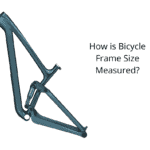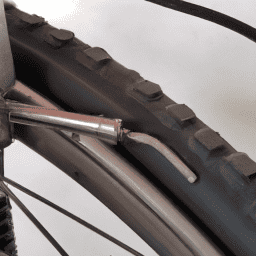As I rode along the road, my bicycle seemed like a part of me. The design and careful craftsmanship of my bike’s length significantly contributed to this feeling of unity.
The dimensions of a bicycle are not arbitrary; they are meticulously calculated to ensure optimal performance, comfort, and safety. From the frame length to the handlebar width, every aspect is carefully considered.
In this article, we will explore the various dimensions of a bicycle, revealing the importance of getting the length just right.
Key Takeaways
- Bicycle dimensions, including frame length and handlebar width, are carefully calculated for optimal performance, comfort, and safety.
- Frame geometry, angles, and dimensions, as well as different frame materials, impact bike handling and rider comfort.
- Wheelbase, the distance between the front and rear wheels, affects stability and maneuverability.
- Handlebar width and stem length directly impact bike maneuverability, control, and overall fit.
Overview of Bicycle Dimensions
Understanding the dimensions of a bicycle is essential for finding the right fit and ensuring a comfortable ride. How long is your bike? It is important to consider the frame materials used. Different materials, such as aluminum, carbon fiber, or steel, can affect the overall length and weight of the bike.
The length of a bike is closely tied to its size and fit. A bike that is too long can be difficult to handle and may cause discomfort, while a bike that is too short can lead to a cramped riding position. Finding the right balance between frame length and size is crucial for optimal performance and riding experience.
With this understanding, let’s now delve into the specifics of frame length and size.
Frame Length and Size
When it comes to bicycles, understanding frame geometry is crucial for a comfortable and efficient ride. The frame length and size play a major role in determining the overall fit and feel of the bike.
By choosing the right frame size, riders can ensure optimal power transfer, handling, and comfort.
Understanding Frame Geometry
The length of a bicycle is influenced by its frame geometry. Understanding frame geometry is crucial in determining the handling and comfort of a bike. Here are five key points to consider:
-
Impact of frame geometry on bike handling: The angles and dimensions of the frame affect how a bike responds to steering inputs and maintains stability. A steeper head tube angle, for example, results in quicker and more responsive handling.
-
How frame geometry affects rider comfort: Frame geometry also plays a role in rider comfort. Factors such as the seat tube angle, top tube length, and stack and reach measurements determine the bike’s fit and how comfortable it feels during long rides.
-
Frame material and its impact on geometry: Different frame materials, such as carbon fiber or aluminum, can influence the geometry of a bike. Carbon frames, for instance, allow for more flexibility in shaping the geometry and optimizing performance.
-
Tube shapes and their effects: The shape and diameter of the tubes used in frame construction also impact the overall geometry. Aero-shaped tubes, for example, reduce drag and increase speed.
-
Wheelbase and stability: The wheelbase, the distance between the front and rear wheels, affects stability. A longer wheelbase provides more stability at higher speeds, while a shorter wheelbase offers quicker handling for tight turns.
Understanding frame geometry is just the first step in choosing the right bike. Now, let’s delve into the importance of selecting the appropriate frame size.
Choosing the Right Frame Size
To choose the right frame size, you should consider your height and inseam measurement.
The frame material is an important factor to consider when choosing a bike. Different materials, such as steel, aluminum, and carbon fiber, have different characteristics that affect the bike’s weight, stiffness, and durability.
Determining the ideal saddle height is crucial for comfort and efficient pedaling. It can be calculated based on your inseam measurement and the type of riding you plan to do.
Once you have chosen the right frame size and material, you can focus on other aspects of bike fit, such as handlebar reach and seat position. These factors, along with wheelbase and overall length, contribute to the bike’s handling and stability.
Wheelbase and Overall Length
The bicycle’s wheelbase and overall length play a crucial role in determining its stability and maneuverability.
The wheelbase refers to the distance between the front and rear axles, while the overall length is the measurement from the front of the bike to the back. These two factors have a significant impact on how the bike handles and its stability during rides.
A longer wheelbase generally provides better stability, especially at high speeds and on rough terrains. On the other hand, a shorter wheelbase offers increased maneuverability, making it easier to navigate tight turns and corners.
Finding the right balance between wheelbase and overall length is essential to ensure optimal bike handling and stability.
Speaking of handling, another important aspect to consider is handlebar width, which I will discuss in the next section.
Handlebar Width
Handlebar width greatly affects the bike’s maneuverability and control. The positioning of handlebar grips is crucial in achieving optimal bike handling and stability. Here are three key reasons why handlebar width is important:
-
Stability: A wider handlebar provides more stability, especially when riding at high speeds or traversing rough terrains. It allows for better control and minimizes the chances of losing balance.
-
Steering responsiveness: The width of the handlebar determines how quickly and efficiently the bike responds to steering inputs. A narrower handlebar offers quicker maneuverability, ideal for navigating tight corners or congested areas.
-
Comfort and leverage: The width of the handlebar affects the rider’s comfort and ability to apply leverage. A wider handlebar allows for a more natural and comfortable grip, reducing strain on the wrists and shoulders.
Considering the significance of handlebar width in bike handling, the next aspect to explore is the stem length, which plays a crucial role in determining the bike’s overall fit and handling characteristics.
Stem Length
Stem length directly impacts a bike’s fit and handling. The stem is the component that connects the handlebars to the fork steerer tube. It determines the distance between the rider and the handlebars, affecting the bike’s overall reach and riding position.
Finding the right stem length is crucial for achieving a comfortable and efficient riding experience. A shorter stem provides a more upright position, ideal for leisurely rides or riders who prefer a more relaxed posture. On the other hand, a longer stem promotes a more aggressive and aerodynamic position, suitable for racing or riders seeking maximum power output.
Therefore, choosing the appropriate stem length is essential for optimizing bike fit and overall performance.
Moving on to the next section, seat tube length also plays a significant role in determining bike fit.
Seat Tube Length
Now that we’ve discussed stem length, let’s move on to another important aspect of bicycle measurement: seat tube length.
The seat tube is the vertical tube that connects the seatpost to the bottom bracket. It plays a crucial role in determining the rider’s position on the bike. The seat tube angle, measured in degrees, affects the rider’s comfort and efficiency.
A steeper seat tube angle positions the rider more forward, making it easier to generate power. On the other hand, a more relaxed seat tube angle allows for a more upright and comfortable riding position.
Another important aspect of seat tube length is the diameter, which determines the size of the seatpost that can be used.
Now that we understand the role of seat tube length, let’s move on to the next section where we’ll discuss top tube length.
Top Tube Length
The top tube length affects the rider’s reach and overall bike fit. It plays a crucial role in determining the comfort and handling of a bicycle. The top tube length refers to the horizontal distance between the seat tube and the head tube.
A longer top tube length typically results in a more stretched-out riding position, suitable for riders with longer torsos or those seeking a more aerodynamic posture. On the other hand, a shorter top tube length allows for a more upright riding position, ideal for riders with shorter torsos or those prioritizing comfort over speed.
Finding the right top tube length is essential for achieving proper bike fit, as it ensures optimal balance, control, and power transfer.
Moving on to the next section about chainstay length, this measurement also plays a crucial role in bike geometry and overall performance.
Chainstay Length
To determine the right chainstay length for you, consider your desired bike handling and stability. The chainstay length plays a crucial role in how your bike handles and feels on the road or trail. Here are four key factors to consider when thinking about chainstay length:
-
Stability: A longer chainstay length provides more stability, making the bike feel steady and predictable, especially at high speeds.
-
Maneuverability: A shorter chainstay length allows for quicker and more nimble handling, making it easier to navigate tight corners and switchbacks.
-
Climbing efficiency: A shorter chainstay length places more weight on the rear wheel, improving traction and climbing efficiency.
-
Compatibility: When choosing a chainstay length, it’s important to consider the seatpost diameter as well. Some seatpost diameters may limit the range of chainstay lengths available.
With chainstay length covered, let’s move on to discussing fork length and its impact on bike performance.
Fork Length
Consider the impact of fork length on your bike’s performance and how it affects your riding experience.
Fork length is a crucial aspect of frame geometry that greatly influences the handling and stability of your bicycle. It refers to the distance from the bottom of the head tube to the axle of the front wheel.
A longer fork length generally results in a more stable ride, especially at high speeds and on rough terrain. It provides greater control and reduces the chances of the front wheel lifting off the ground during steep descents.
On the other hand, a shorter fork length offers quicker steering response and improved maneuverability, making it ideal for tight turns and technical trails.
The choice of fork length ultimately depends on your riding style and the type of terrain you frequent.
Now let’s delve into the next aspect of bike geometry: crankarm length.
Crankarm Length
Crankarm length greatly impacts your biking experience and affects how efficiently you pedal. It is a crucial component that connects the pedals to the bottom bracket. The length of the crankarm determines the amount of leverage you have while pedaling, which directly affects your power output and pedal stroke efficiency.
When it comes to crankarm materials, they are typically made from aluminum or carbon fiber. Aluminum crankarms are known for their durability and affordability, while carbon fiber crankarms offer a lighter weight and increased stiffness for better power transfer.
In terms of crankarm design, there are various options available, including standard, compact, and triple. Each design has its advantages and is suitable for different types of riding and terrain.
Considering the importance of crankarm length and design, it is crucial to choose the right one based on your riding style and preferences. This will ensure optimal pedaling efficiency and overall biking performance.
Speaking of pedaling efficiency, the next section will delve into the pedal-to-saddle distance and its impact on your biking experience.
Pedal-to-Saddle Distance
The pedal-to-saddle distance greatly affects your comfort and efficiency while biking. It refers to the distance between the pedals when they are at their lowest point in the pedal stroke. This distance is crucial because it determines how far you need to extend your legs when pedaling.
If the pedal-to-pedal distance is too short, you may experience knee pain and discomfort. On the other hand, if it is too long, you may not be able to fully extend your legs, resulting in decreased power and efficiency.
Additionally, the pedal-to-saddle distance affects your knee-to-handlebar distance, which determines your overall riding position and comfort. Finding the right balance between these two distances is essential for a comfortable and efficient biking experience.
Speaking of comfort, the next subtopic we will discuss is ‘standover height.’
Standover Height
In our previous discussion about pedal-to-saddle distance, we explored the importance of finding the right position for efficient pedaling.
Now, let’s delve into another crucial aspect of bicycle fit: standover height. Standover height refers to the distance between the top tube of the bicycle frame and the ground when you straddle the bike with your feet flat on the floor.
It is an important measurement to consider, especially for riders with shorter inseams or those who are concerned about stability when coming to a stop. Standover height is closely tied to frame size, as different frame sizes will offer varying standover heights.
By understanding and considering your standover height, you can ensure a comfortable and safe fit for your bicycle.
Now, let’s explore how we can adjust the bike length for even greater comfort.
Adjusting Bike Length for Comfort
Adjusting the bike length can greatly enhance the comfort of your ride. When it comes to adjusting the length of your bike, there are a few key factors to consider.
One important aspect is the bike angle. By adjusting the angle of the bike, you can fine-tune the length to suit your body and riding style. This can make a big difference in your overall comfort and performance.
Another factor to consider is the actual length of the bike. Depending on your height and preferred riding position, you may need to lengthen or shorten the bike to achieve the optimal fit. Making these adjustments can help prevent discomfort and even improve your speed and efficiency.
Considering these factors, let’s now delve into the considerations for different types of bicycles.
Considerations for Different Types of Bicycles
To achieve the optimal fit for your bike, it’s important to take into account the specific type of bike you are riding. Bike sizing varies depending on the type of bicycle, and there are several factors that affect bike fit.
One important consideration is the frame size. Different types of bikes have different frame geometries that can affect how the bike fits your body. For example, road bikes typically have a more aggressive riding position with a longer top tube, while mountain bikes have a more upright position with a shorter top tube.
Another factor to consider is the handlebar width. Narrower handlebars can give you a more aerodynamic position, while wider handlebars provide better stability and control. Pedal position, saddle height, and stem length are also important factors affecting bike fit.
By considering these factors, you can ensure that your bike is sized correctly for your comfort and riding style.
Transitioning into the next section, it is crucial to understand the importance of proper bike length for an enjoyable and safe riding experience.
Conclusion: The Importance of Proper Bike Length
Now that we have explored the various considerations for different types of bicycles, it is clear that the length of a bike plays a crucial role in its performance and overall ride quality. The importance of proper fit cannot be overstated, as it directly affects your comfort, control, and efficiency on the bike. A bike that is too long or too short can lead to discomfort, inefficient pedaling, and even injury.
Proper bike length impacts your performance in several ways. Firstly, it allows for optimal power transfer, ensuring that each pedal stroke propels you forward efficiently. Secondly, it enables you to maintain a comfortable and aerodynamic riding position, which can significantly improve your speed and endurance.
To further emphasize the significance of proper fit, let’s delve into two key subtopics: the impact of bike length on comfort and the effect it has on handling and control.
Frequently Asked Questions
What are the different factors to consider when adjusting the length of a bicycle for comfort?
When adjusting the length of a bicycle for comfort, factors to consider include the rider’s height, flexibility, riding style, and intended use. These factors will determine the optimal length that ensures a comfortable and efficient riding experience.
How does the length of a bicycle affect its maneuverability and stability?
The length of a bicycle affects its maneuverability and stability. For example, a shorter bike with a compact frame offers better maneuverability, making it easier to navigate tight corners. However, a longer bike with a stretched-out frame provides more stability, especially at high speeds. Finding the right balance between maneuverability and stability is crucial for both comfort and performance.
Are there any safety concerns related to having a bike that is too long or too short?
Having a bike that is too long or too short can pose safety concerns. A bike with a frame size that is too small can result in a cramped riding position, while a saddle height that is too high can compromise stability and control.
Can the length of a bicycle be adjusted after it has been purchased?
Adjusting the length of a bicycle frame is possible using bike fit techniques. One interesting statistic is that a proper bike fit can increase power output by 7-15%.
Are there any specific recommendations for adjusting the length of different types of bicycles, such as road bikes or mountain bikes?
For optimal handlebar width, road bikes typically have narrower bars for aerodynamics, while mountain bikes have wider bars for better control. Frame geometry plays a crucial role in adjusting the length of a bicycle to ensure proper fit and comfort.
Conclusion
In conclusion, it’s crucial to understand the importance of proper bike length for optimal comfort and performance. By considering factors such as frame length, wheelbase, handlebar width, and stem length, cyclists can ensure a bike that fits their body and riding style.
For example, let’s imagine a scenario where a professional mountain biker is preparing for a challenging downhill race. With a bike that is too long, their control and maneuverability would be compromised, increasing the risk of accidents.
Thus, adjusting bike length is essential for a safe and enjoyable ride.
















